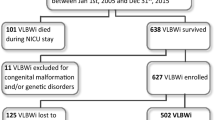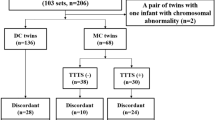Abstract
Background
Twins are considered to be at an increased risk for perinatal mortality and morbidities, but it is unclear whether preterm twins are at an increased risk for poor developmental outcomes when compared to preterm singletons. Our aim was to compare the neurodevelopmental outcome of preterm twins vs singletons at 5 years of age.
Methods
Very low birth weight and very low gestational age infants (twins n = 66, singletons n = 157) were recruited as a part of the PIPARI project in the Turku University Hospital, covering a regional population. Cognitive development, neuropsychological performance, and neurodevelopmental impairments (including cerebral palsy, hearing deficit, visual impairment, and intellectual disability) were evaluated at 5 years of age.
Results
Twins and singletons had otherwise similar perinatal background factors, except for the higher proportion of preterm rupture of membranes in singletons. Twins had cognitive and neuropsychological outcomes that were otherwise comparable with singletons, but they had a slightly lower verbal intelligence quotient (estimate −5.81, 95% CI −11.14 to −0.48, p = 0.03). Being a twin was not a risk for neurodevelopmental impairments.
Conclusions
Our study shows that, contrary to a common hypothesis, the overall neurodevelopment of very preterm twins does not significantly differ from that of preterm singletons.
Similar content being viewed by others
Log in or create a free account to read this content
Gain free access to this article, as well as selected content from this journal and more on nature.com
or
References
Resch, B. et al. Preterm twin and triplet pregnancies are at increased risk for the development of cystic periventricular leukomalacia. Eur. J. Paediatr. Neurol. 17, 148–152 (2013).
Garg, P. et al. Perinatal characteristics and outcome of preterm singleton, twin and triplet infants in NSW and the ACT, Australia (1994-2005). Arch. Dis. Child. Fetal Neonatal Ed. 95, F20–F24 (2010).
Vasak, B. et al. Lower perinatal mortality in preterm born twins than in singletons: a nationwide study from The Netherlands. Am. J. Obstet. Gynecol. 216, 161.e1–161.e9 (2017).
Christensen, K. et al. Comparison of academic performance of twins and singletons in adolescence: follow-up study. BMJ. 333, 1095 (2006).
Bodeau-Livinec, F. et al. Do very preterm twins and singletons differ in their neurodevelopment at 5 years of age? Arch. Dis. Child. Fetal Neonatal Ed. 98, F480–F487 (2013).
Lorenz, J. M. Neurodevelopmental outcomes of twins. Semin. Perinatol. 36, 201–212 (2012).
Ronalds, G. A., De Stavola, B. L. & Leon, D. A. The cognitive cost of being a twin: evidence from comparisons within families in the Aberdeen children of the 1950s cohort study. BMJ. 331, 1306 (2005).
Wadhawan, R. et al. Twin gestation and neurodevelopmental outcome in extremely low birth weight infants. Pediatrics 123, e220–e227 (2009).
Iannone, G. et al. Long-term neuropsychological outcome in preterm twins. ScientificWorldJournal 6, 899–907 (2006).
Simões, T. et al. Outcome of monochorionic twins conceived by assisted reproduction. Fertil. Steril. 104, 629–632 (2015).
Glinianaia, S. V., Obeysekera, M. A., Sturgiss, S. & Bell, R. Stillbirth and neonatal mortality in monochorionic and dichorionic twins: a population-based study. Hum. Reprod. 26, 2549–2557 (2011).
Masheer, S., Maheen, H. & Munim, S. Perinatal outcome of twin pregnancies according to chorionicity: an observational study from tertiary care hospital. J. Matern. Neonatal Med. 28, 23–25 (2015).
Cordero, L., Franco, A. & Joy, S. D. Monochorionic monoamniotic twins: neonatal outcome. J. Perinatol. 26, 170–175 (2006).
Papiernik, E. et al. Differences in outcome between twins and singletons born very preterm: results from a population-based European cohort. Hum. Reprod. 25, 1035–1043 (2010).
Luo, Z. C., Ouyang, F., Zhang, J. & Klebanoff, M. Perinatal mortality in second- vs firstborn twins: A matter of birth size or birth order? Am. J. Obstet. Gynecol. 211, 153.e1–153.e8 (2014).
Manzanares, S. et al. Perinatal outcomes in preterm growth-restricted twins: effects of gestational age and fetal condition. Twin Res. Hum. Genet. 16, 727–731 (2013).
Hack, K. E. A. et al. Long-term neurodevelopmental outcome of monochorionic and matched dichorionic twins. PLoS ONE 4, e6815 (2009).
Townsend, R. & Khalil, A. Twin pregnancy complicated by selective growth restriction. Curr. Opin. Obstet. Gynecol. 28, 485–91. (2016).
Halling, C. et al. Neuro-developmental outcome of a large cohort of growth discordant twins. Eur. J. Pediatr. 175, 381–389 (2016).
National Institute for Health and Welfare. Statistical Report. Newborns (NIHW, 2014).
Manuck, T. A., Sheng, X., Yoder, B. A. & Varner, M. W. Correlation between initial neonatal and early childhood outcomes following preterm birth. Am. J. Obstet. Gynecol. 210, 426.e1–9 (2014).
Gnanendran, L., Bajuk, B., Oei, J., Lui, K. & Abdel-Latif, M. E. Neurodevelopmental outcomes of preterm singletons, twins and higher-order gestations: a population-based cohort study. Arch. Dis. Child. Fetal Neonatal Ed. 100, F106–F114 (2015).
Eras, Z. et al. Neurodevelopmental outcome among multiples and singletons: a regional neonatal intensive care unit’s experience in Turkey. Twin Res. Hum. Genet. 16, 614–618 (2013).
Petit, N., Cammu, H., Martens, G. & Papiernik, E. Perinatal outcome of twins compared to singletons of the same gestational age: a case-control study. Twin Res. Hum. Genet. 14, 88–93 (2011).
Ray, B. & Platt, M. P. W. Mortality of twin and singleton livebirths under 30 weeks’ gestation: a population-based study. Arch. Dis. Child. Fetal Neonatal Ed. 94, F140–F143 (2009).
Einaudi, M.-A. et al. Neuropsychological screening of a group of preterm twins: comparison with singletons. Childs Nerv. Syst. 24, 225–230 (2008).
Kyriakidou, M. et al. Comparison of 24 months neurodevelopmental outcome in twins and singletons. J. Pediatr. Neonatal Individ. Med. 2, 48–54 (2013).
Raz, S. et al. Neuropsychological functioning in preterm-born twins and singletons at preschool age. J. Int. Neuropsychol. Soc. 22, 865–877 (2016).
Hajnal, B. L., Braun-Fahrländer, C., von Siebenthal, K., Bucher, H. U. & Largo, R. H. Improved outcome for very low birth weight multiple births. Pediatr. Neurol. 32, 87–93 (2005).
Setänen, S., Haataja, L., Parkkola, R., Lind, A. & Lehtonen, L. Predictive value of neonatal brain MRI on the neurodevelopmental outcome of preterm infants by 5 years of age. Acta Paediatr. Int. J. Paediatr. 102, 492–497 (2013).
Haataja, L. et al. Optimality score for the neurologic examination of the infant at 12 and 18 months of age. J. Pediatr. 135, 153–161 (1999).
Palisano, R. et al. Development and reliability of a system to classify gross motor function in children with cerebral palsy. Dev. Med. Child Neurol. 39, 214–223 (2008).
Wechsler, D. Wechslerin Älykkyystestistö Esikouluikäisille, Käsikirja (Psykologin kustannus, Helsinki, 1995).
Korkman, M., Kirk, U. & Kemp, S. NEPSY II (Psykologien Kustannus, Helsinki, 2008).
Korkman, M., Kirk, U. & Kemp, S. NEPSY II 2nd edn. (Psychological Corporation, San Antonio, 2007).
Lind, A. et al. Relations between brain volumes, neuropsychological assessment and parental questionnaire in prematurely born children. Eur. Child Adolesc. Psychiatry 19, 407–417 (2010).
Logan, J. W. et al. Neurocognitive function of 10-year-old multiples born less than 28 weeks of gestational age. J. Perinatol. 39, 237–247 (2019).
Thorpe, K., Rutter, M. & Greenwood, R. Twins as a natural experiment to study the causes of mild language delay: II: Family interaction risk factors. J. Child Psychol. Psychiatry 44, 342–355 (2003).
Thorpe, K., Greenwood, R., Eivers, A. & Rutter, M. Prevalence and developmental course of “secret language”. Int. J. Lang. Commun. Disord. 36, 43–62 (2001).
Rutter, M., Thorpe, K., Greenwood, R., Northstone, K. & Golding, J. Twins as a natural experiment to study the causes of mild language delay: I: Design; twin-singleton differences in language, and obstetric risks. J. Child Psychol. Psychiatry 44, 326–341 (2003).
Kawamura, H. et al. Significance of chorionicity on long-term outcome of low birthweight infants of <1500g in twin pregnancies. J. Obstet. Gynaecol. Res. 41, 1185–1192 (2015).
Shah, P. S. et al. Neonatal outcomes of very preterm or very low birth weight triplets. Pediatrics 142, e20181938 (2018).
Acknowledgements
This study was supported by grants from the South-Western Finnish Foundation of Neonatal Research and the C.G. Sundell foundation.
Members of the PIPARI study group
Karoliina Aho, Annarilla Ahtola, Satu Ekblad, Eeva Ekholm, Leena Haataja, Camilla Hagelstam, Mira Huhtala, Maija Juntunen, Pentti Kero, Mari Koivisto, Riikka Korja, Satu Korpela, Katri Lahti, Helena Lapinleimu, Liisa Lehtonen, Tuomo Lehtonen, Marika Leppänen, Annika Lind, Hanna Manninen, Jonna Maunu, Petriina Munck, Laura Määttänen, Pekka Niemi, Anna Nyman, Pertti Palo, Riitta Parkkola, Päivi Rautava, Katriina Saarinen, Susanna Salomäki, Virva Saunavaara, Sirkku Setänen, Matti Sillanpää, Suvi Stolt, Päivi Tuomikoski-Koiranen, Timo Tuovinen, Anniina Väliaho, Milla Ylijoki
Author information
Authors and Affiliations
Consortia
Contributions
M.Y.: Took part in the design of the study and statistical analyses and interpretation of data and drafted the initial manuscript. L.H., A.L., E.E. and L.L.: Took part in the design of the study and statistical analyses and interpretation of data and critically reviewed and revised the manuscript. All authors approved the final manuscript as submitted and agree to be accountable for all aspects of the work.
Corresponding author
Ethics declarations
Competing interests
The authors declare no competing interests.
Additional information
Publisher’s note Springer Nature remains neutral with regard to jurisdictional claims in published maps and institutional affiliations.
Members of the PIPARI study group are listed at the end of the paper.
Supplementary information
Rights and permissions
About this article
Cite this article
Ylijoki, M., Haataja, L., Lind, A. et al. Neurodevelopmental outcome of preterm twins at 5 years of age. Pediatr Res 87, 1072–1080 (2020). https://doi.org/10.1038/s41390-019-0688-x
Received:
Revised:
Accepted:
Published:
Issue date:
DOI: https://doi.org/10.1038/s41390-019-0688-x



